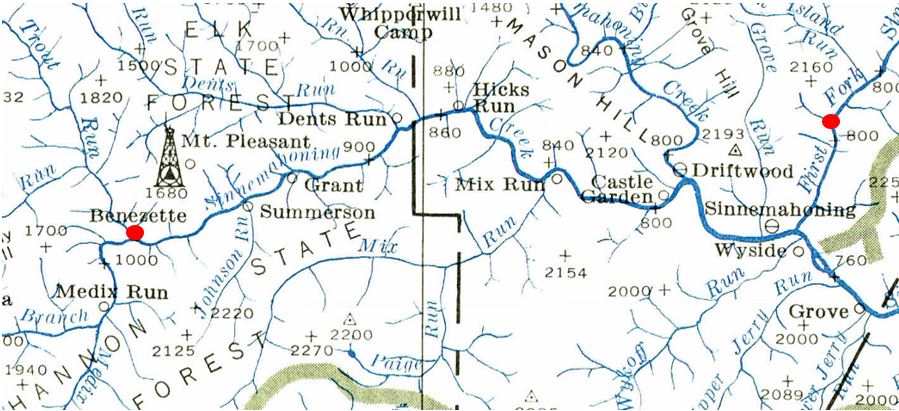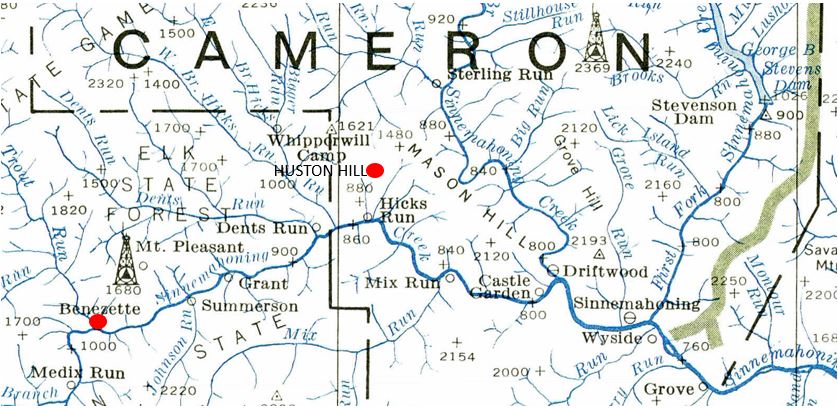
- Details
- Category: Elk Tales
- Hits: 1522
ONE DAY ONLY - SATURDAY, OCTOBER 12, 2024 FROM 10 AM TO 4 PM
Elktoberfest is a unique, small Fall festival in the heart of Elk Country held at our beautiful Benezette School! Home made chili, home made chicken noodle soup, smoked pork sandwiches and baked goods. Talented crafters, photographers and bakers will have their work on sale.
Join us for a fun-filled Autumn day in Benezette.
Proceeds help us to preserve the Benezette School - thank you for your support!

Benezette, Pennsylvania (where did that name come from?) is well-known for the elk who live in the woods and fields around this small northern Pennsylvania town. But before the elk returned, generations of hunters, farmers, woodcutters, sawyers, coal miners, railroaders, tanners and well-drillers worked here. Their wives, moms, and sisters worked at "keeping house" and often earned a few dollars by putting their skills to work. The village bustled with these working people who found ways to hang on through the many changes of the last 200 years. What are their stories?

This effort was inspired by conversations with members of the Benezette School Committee. These volunteers have worked for more than 30 years to preserve and maintain the historic Benezette School. The building is now the gem of the community. It is very much a part of the present scene as the location of the township offices, elections, community events and, of course, Elktoberfest! Talking with them, most of whom have lived in Benezette for decades, reveals the story of a busy and vibrant community that has survived good times and bad times. We need to the know the stories of these folks and their neighbors, and that's what you can find here.
The information you'll find here has been extracted from newspapers, county histories, the federal census, interviews and more. Each fact is like a loose thread - once you start tugging on it, it gets longer and longer, leading to more facts. If you have ever tried to track down the story of your own family, you know that one fact leads to another, and there are always some that you aren't sure are relevant - yet - but something tells you to just file them away for now. You can read some of that here. Good historians don't speculate or make up stories when they don't have the facts, but they do ask questions. Short explanations within articles demonstrate this practice, so this is a presentation of both the stories and the process.
This is just the beginning. As the research continues, stories that are short now will be expanded and new stories will be added, so come back often. Enjoy!
Subcategories
Business
Who were the innkeepers and merchants in Benezette?
Campfire stories
Stories that may or may not be true but are fun to share.
Hunting stories, Philip Tome, 1854
Philip Tome was a well-known Indian-language interpreter and hunter of northern Pennsylvania. Born in 1782, his family moved up the West Branch of the Susquehanna to Pine Creek in November 1791, when Philip was just nine years old. He noted that “at that time game such as bears, elk, deer and wild turkeys were very plenty” and that his two older brothers were old enough to hunt but the only gun in the family was an old musket “and that was out of order.” The family was visited by two neighbors in December who brought two guns and two dogs but no ammunition. Tome's father was able to supply lead shot and gunpowder, and within two days, they killed four deer and two large, fat bears, providing a quick supply of meat to sustain the family into the winter. (Tome 1854: 10-11)
In his own words, Tome explains that “in presenting the following incidents of my life to the public, I do not intend to claim for it beauty of expression for it is the production of one born in the wilderness; one who is more conversant with the howl of the wolf and panther and the whoop of the savage than the tones of oratory, as heard in civilized life. . . . Those in pursuit of the marvelous will not be disappointed.”
Tome published his hunting stories in the book Pioneer life, or thirty years a hunter (1854). Tome's stories are great hunting stories - there's enough detail to help us understand what living in the northern forests of Pennsylvania was like in the early 1800s, but there's also enough - well let's just say embellishment - to make it a good hunting story. Is it history? Well, not quite - his stories often lack the details needed to tie them to specific people, places and dates and it's not always clear if these were events he actually witnessed or if they were stories he'd heard, so their are crediblity issues. But as part of the oral history of the region they are invaluable. And marvelous!
A word of caution - Tome's stories are about the catching and killing of animals and may not be appropriate for more sensitive audiences.
Environment and wildlife
An early folklorist referred to the deep woods of northern Pennsylvania as the "Black Forest." The name didn't stick as a descriptor, but it does suggest the nature of the environment. The original forest of ancient pines and hemlocks was cut and replaced by maple and beech trees that shrouded the landscape in shadow. Despite aggressive logging throughout the 19th century, there remained large tracts of forested land, with plants and animals well-adapted to the changing environment.
History
Where did the name Benezette come from? How has the town changed?
Pioneer history
At the end of the 18th and beginning of the 19th centuries, Elk County was the frontier of European settlement.
People
Who were the people who lived in and around Benezette? Who came to Benezette and made a difference? Who stayed?
Civic duties
How did people engage with local government? While a list of jurors or tax assessments may not be compelling reading, it helps us to piece together the story of who was in Benezette.
First people
The first people arrived in what we today call Benezette at the end of the Ice Age about 10,000 years ago. They were the ancestors of modern American Indians and evidence of their presence is represented by artifacts and human remains that have been uncovered. This evidence is scattered but we can draw some conclusions from archaeological evidence in central and northern Pennsylvania and southern New York.
Civilian Conservation Corps, 1933
During the Depression, a Civilian Conservation Corps company was posted to Benezette, Pennsylvania.
Iris of Progress
The Iris of Progress was a monthly newsletter published by the Benezett camp (Company 303, “Camp Vann”) from 1935-1938 (“the official organ of CCC Camp Vann, published by the enrollees”).
The transcripts provided here are minimally edited in order to preserve the voices of the young black men who served, in the original vernacular of the 1930s, just as they wrote it.
Philadelphia Tribune
Many enrollees at the camp were from Philadelphia, and they sent a steady stream of news back home that was published in the city's largest black newspaper, the Philadelphia Tribune. Unlike the Iris of Progress which was produced at the camp, letters sent to the Tribune did not need to be reviewed by camp supervisory personnel.
Pittsburgh Courier
There were also many enrollees from Pittsburgh, PA and they sent their stories home to the city's black newspaper, the Pittsburgh Courier. The camp at Benezette was called "Camp Vann" in honor of the paper's editor, Robert Lee Vann.
Neighbors
Benezette never had its own newspaper but there were several in the surrounding communities. Most papers had a column for local news from nearby communities. This "news" often included weather observations, social events, even a little gossip. It was the Facebook of a century ago!
Sinnemahoning

Map source:
Higbee, Howard Wm. 1965. Stream map of Pennsylvania. University Park, PA: Pennsylvania State University. https://digital.libraries.psu.edu/digital/collection/maps1/id/2772/
Sterling Run

Higbee, Howard Wm. 1965. Stream map of Pennsylvania. University Park, PA: Pennsylvania State University. https://digital.libraries.psu.edu/digital/collection/maps1/id/2772/
First Fork

Map source:
Higbee, Howard Wm. 1965. Stream map of Pennsylvania. University Park, PA: Pennsylvania State University. https://digital.libraries.psu.edu/digital/collection/maps1/id/2772/
Mason Hill

Map source:
Higbee, Howard Wm. 1965. Stream map of Pennsylvania. University Park, PA: Pennsylvania State University. https://digital.libraries.psu.edu/digital/collection/maps1/id/2772/
Huston Hill

Map source:
Higbee, Howard Wm. 1965. Stream map of Pennsylvania. University Park, PA: Pennsylvania State University. https://digital.libraries.psu.edu/digital/collection/maps1/id/2772/
Ouch!
Injuries, bug bites, sickness - what's hurting?
Railroads
Wouldn't it be sweet if you could still catch a train to Benezette? A hundred years ago, this was the fastest way to travel from town to town.
